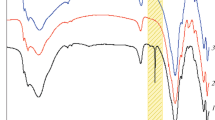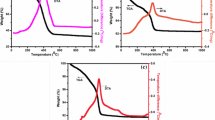Abstract
The goal of this paper is to study the catalytic activity of clay-based materials doped by silver, copper, and gold nanoparticles in the Suzuki–Miyaura coupling reaction. The catalysts are prepared by homogeneous deposition precipitation at 2 wt% of metal. The properties of the catalysts were obtained using these methods: SEM (scanning electron microscopy), high-angle annular dark field, EDS (energy dispersive spectroscopy), DRS/UV–Vis (diffuse reflectance spectroscopy, UV–Vis), XRD (x-ray diffraction), ICP (elementary analysis), and adsorption–desorption of N2 and infrared spectroscopy. The results showed an almost total homogeneous deposition of the metallic nanoparticles on the clay surface. All the catalysts were used in the synthesis of biphenyls using the Suzuki–Miyaura reaction with phenylboronic acid and different aryl halides under classical heating or under visible irradiation. The results have shown the obtaining of interesting coupling rates exceeding 5.44 mol/h/g which depend on the catalyst nature, the aryl halide, and the mode of the activation of the reaction. The different reaction conditions have been optimized.











Similar content being viewed by others
References
V. Farina, New perspectives in the cross-coupling reactions of organostannanes. J. Pure Appl. Chem. 68, 73 (1996).
D. Zhang, and Q. Wang, Palladium catalyzed asymmetric Suzuki–Miyaura coupling reactions to axially chiral biaryl compounds: chiral ligands and recent advances. Coord. Chem. Rev. 286, 1 (2015).
M. Sainsbury, Modern methods of aryl-aryl bond formation. Tetrahedron 36, 3327 (1980).
M. Al-Amin, M. Akimoto, T. Tameno, Y. Ohki, N. Takahashi, N. Hoshiya, S. Shuto, and M. Arisawa, Suzuki–Miyaura cross-coupling reactions using a low-leaching and highly recyclable gold-supported palladium material and two types of microwave equipments. Green Chem. 15, 1142 (2013).
D.K. Dumbre, P.N. Yadav, S.K. Bhargava, and V.R. Choudhary, Suzuki-Miyaura cross-coupling reaction between aryl halides and phenylboronic acids over gold nano-particles supported on MgO (or CaO) and other metal oxides. J. Catal. 301, 134 (2013).
C. González-Arellano, A. Corma, M. Iglesias, and F. Sánchez, Gold (I) and (III) catalyze Suzuki cross-coupling and homocoupling, respectively. J. Catal. 238, 497 (2006).
J. Han, Y. Liu, and R. Guo, Facile synthesis of highly stable gold nanoparticles and their unexpected excellent catalytic activity for Suzuki–Miyaura cross-coupling reaction in water. J. Am. Chem. Soc. 131, 2060 (2009).
M.M. Khodaei, and M. Dehghan, A green and cost-effective approach for the production of gold nanoparticles using corn silk extract: a recoverable catalyst for Suzuki–Miyaura reaction and adsorbent for removing of dye pollutants. Polyhedron 162, 219 (2019).
J. Ma, X. Cui, B. Zhang, M. Song, and Y. Wu, Ferrocenylimidazoline palladacycles: efficient phosphine-free catalysts for Suzuki–Miyaura cross-coupling reaction. Tetrahedron 63, 5529 (2007).
N. Miyaura, Metal-catalyzed cross-coupling reactions of organoboron compounds with organic halides, Metal-catalyzed cross-coupling reactions. (Weinheim: Wiley, 2004), pp. 41–123.
N. Miyaura, and A. Suzuki, Palladium-catalyzed cross-coupling reactions of organoboron compounds. Chem. Rev. 95, 2457 (1995).
S.K. Movahed, S. Miraghaee, and M. Dabiri, AuPd alloy nanoparticles decorated graphitic carbon nitride as an excellent photocatalyst for the visible-light-enhanced Suzuki–Miyaura cross-coupling reaction. J. Alloys Compd. 819, 152994 (2020).
M. Pérez-Lorenzo, Palladium nanoparticles as efficient catalysts for Suzuki cross-coupling reactions. J. Phys. Chem. Lett. 3, 167 (2012).
H.H. Shin, E. Kang, H. Park, T. Han, C.-H. Lee, and D.-K. Lim, Pd-nanodot decorated MoS2 nanosheets as a highly efficient photocatalyst for the visible-light-induced Suzuki–Miyaura coupling reaction. J. Mater. Chem. A 5, 24965 (2017).
M.G. Speziali, A.G. Marques, D. da Silva, M. Vaz, A. de Miranda, L. Monteiro, and P.A. Robles-Dutenhefner, Air stable ligandless heterogeneous catalyst systems based on Pd and Au supported in SiO2 and MCM-41 for Suzuki–Miyaura cross-coupling in aqueous medium. Appl. Catal. A 462–463, 39 (2013).
P. Verma, K. Tamaki, T. Shimojitosho, T. Yoshii, Y. Kuwahara, K. Mori, and H. Yamashita, Size effects in plasmonic gold nanorod based Pd-rGO hybrid catalyst for promoting visible-light-driven Suzuki–Miyaura coupling reaction. Catal. Today 410, 332 (2023).
Q. Xiao, S. Sarina, E. Jaatinen, J. Jia, D.P. Arnold, H. Liu, and H. Zhu, Efficient photocatalytic Suzuki cross-coupling reactions on Au-Pd alloy nanoparticles under visible light irradiation. Green Chem. 16, 4272 (2014).
J.J. YinLiebscher, Carbon−carbon coupling reactions catalyzed by heterogeneous palladium catalysts. Chem. Rev. 107, 133 (2007).
T. Yoshii, Y. Kuwahara, K. Mori, and H. Yamashita, Design of Pd–graphene–Au nanorod nanocomposite catalyst for boosting Suzuki–Miyaura coupling reaction by assistance of surface plasmon resonance. J. Phys. Chem. C 123, 24575 (2019).
J. Zhi, D. Song, Z. Li, X. Lei, and A. Hu, Palladium nanoparticles in carbon thin film-lined SBA-15 nanoreactors: efficient heterogeneous catalysts for Suzuki–Miyaura cross coupling reaction in aqueous media. Chem. Commun. 47, 10707 (2011).
T.R. Martin, C.A. Fortulan, Projeto de uma máquina de usinagem de protótipos de isoladores cerâmicos em escala reduzida, Resumos, (2008)
P.L. Boulas, M. Gómez-Kaifer, and L. Echegoyen, Electrochemistry of supramolecular systems. Angew. Chem. Int. End. 37, 216 (1998).
T. Yoshii, Y. Kuwahara, K. Mori, and H. Yamashita, Promotional effect of surface plasmon resonance on direct formation of hydrogen peroxide from H2 and O2 over Pd/Graphene-Au nanorod catalytic system. J. Catal. 394, 259 (2021).
Z.-H. Gao, K. Wei, T. Wu, J. Dong, D.-E. Jiang, S. Sun, and L.-S. Wang, A heteroleptic gold hydride nanocluster for efficient and selective electrocatalytic reduction of CO2 to CO. J. Am. Chem. Soc. 144, 5258 (2022).
A. Mousavi-Majd, S. Ghasemi, and S.R. Hosseini, Zeolitic imidazolate framework derived porous ZnO/Co3O4 incorporated with gold nanoparticles as ternary nanohybrid for determination of hydrazine. J. Alloys Compd. 896, 162922 (2022).
S. Lapointe, A. Sarbajna, and V.H. Gessner, Ylide-substituted phosphines: a platform of strong donor ligands for gold catalysis and palladium-catalyzed coupling reactions. Acc. Chem. Res. 55, 770 (2022).
N. Ameur, G. Ferouani, Z. Belkadi, R. Bachir, J.J. Calvino, and A. Hakkoum, A novel approach for the preparation of silver nanoparticles supported on titanate nanotubes and bentonite-application in the synthesis of heterocyclic compound derivatives. Mater. Res. Express 6, 125051 (2019).
G. Ferouani, N. Ameur, and R. Bachir, Preparation and characterization of supported bimetallic gold–iron nanoparticles, and its potential for heterogeneous catalysis. Res. Chem. Intermed. 46, 1373 (2020).
D. Han, Z. Bao, H. Xing, Y. Yang, Q. Ren, and Z. Zhang, Fabrication of plasmonic Au–Pd alloy nanoparticles for photocatalytic Suzuki–Miyaura reactions under ambient conditions. Nanoscale 9, 6026 (2017).
J. Chen, J. Cen, X. Xu, and X. Li, The application of heterogeneous visible light photocatalysts in organic synthesis. Catal. Sci. Technol. 6, 349 (2016).
Q. Xiang, J. Yu, and M. Jaroniec, Chem. Soc. Rev. 41, 782 (2012).
Y. Chen, and L. Feng, Silver nanoparticles doped TiO2 catalyzed Suzuki-coupling of bromoaryl with phenylboronic acid under visible light. J. Photochem. Photobiol. B 205, 111807 (2020).
Z. Kaszkur, Nanopowder diffraction analysis beyond the Bragg law applied to palladium. J. Appl. Crystallogr. 33, 87 (2000).
M. Cozzolino, M. Di Serio, R. Tesser, and E. Santacesaria, Grafting of titanium alkoxides on high-surface SiO2 support: An advanced technique for the preparation of nanostructured TiO2/SiO2 catalysts. Appl. Catal. A 325, 256 (2007).
E.A. Cloutis, K.A. McCormack, J.F. Bell, A.R. Hendrix, D.T. Bailey, M.A. Craig, S.A. Mertzman, M.S. Robinson, and M.A. Riner, Ultraviolet spectral reflectance properties of common planetary minerals. Icarus 197, 321 (2008).
R. Zanella, S. Giorgio, C.-H. Shin, C.R. Henry, and C. Louis, Characterization and reactivity in CO oxidation of gold nanoparticles supported on TiO2 prepared by deposition-precipitation with NaOH and urea. J. Catal. 222, 357 (2004).
S. Oros-Ruiz, R. Zanella, S.E. Collins, A. Hernández-Gordillo, and R. Gómez, Photocatalytic hydrogen production by Au–MxOy (MAg, Cu, Ni) catalysts supported on TiO2. Catal. Commun. 47, 1 (2014).
A. Chrouda, S. Mahmoud Ali Ahmed, and M. Babiker Elamin, Preparation of nanocatalysts using deposition precipitation with urea: mechanism, advantages and results. ChemBioEng Rev. 9, 248 (2022).
S.F. Azha, L. Sellaoui, E.H.E. Yunus, C.J. Yee, A. Bonilla-Petriciolet, A. Ben Lamine, and S. Ismail, Iron-modified composite adsorbent coating for azo dye removal and its regeneration by photo-Fenton process: synthesis, characterization and adsorption mechanism interpretation. Chem. Eng. J. 361, 31 (2019).
M. Ghiaci, M.E. Sedaghat, H. Aghaei, and A. Gil, Synthesis of CdS- and ZnS-modified bentonite nanoparticles and their applications to the degradation of eosin B. J. Appl. Chem. Biotechnol. 84, 1908 (2009).
Y. Li, J. Zhan, L. Huang, H. Xu, H. Li, R. Zhang, and S. Wu, Synthesis and photocatalytic activity of a bentonite/g-C3N4 composite. RSC Adv. 4, 11831 (2014).
K.-H. Hu, D.-F. Zhao, and J.-S. Liu, Synthesis of nano-MoS2/bentonite composite and its application for removal of organic dye. Trans. Nonferrous Met. Soc. China 22, 2484 (2012).
D. Rostamzadeh, and S. Sadeghi, Ni doped zinc oxide nanoparticles supported bentonite clay for photocatalytic degradation of anionic and cationic synthetic dyes in water treatment. J. Photochem. Photobiol. A 431, 113947 (2022).
G.M. Scheuermann, L. Rumi, P. Steurer, W. Bannwarth, and R. Mülhaupt, Palladium nanoparticles on graphite oxide and its functionalized graphene derivatives as highly active catalysts for the Suzuki−Miyaura coupling reaction. J. Am. Chem. Soc. 131, 8262 (2009).
A. Balanta, C. Godard, and C. Claver, Pd nanoparticles for C-C coupling reactions. Chem. Soc. Rev. 40, 4973 (2011).
S. Ghorai, A.K. Sarkar, A.B. Panda, and S. Pal, Effective removal of Congo red dye from aqueous solution using modified xanthan gum/silica hybrid nanocomposite as adsorbent. Bioresour. Technol. 144, 485 (2013).
N. Ameur, Z. Fandi, F. Taieb-Brahimi, G. Ferouani, S. Bedrane, and R. Bachir, A novel approach of ceria nanotubes and plasmonic metal-doped ceria nanotubes application: anticorrosion and photodegradation potential. Appl. Phys. A 127, 162 (2021).
Z. Zheng, T. Tachikawa, and T. Majima, Plasmon-enhanced formic acid dehydrogenation using anisotropic Pd–Au nanorods studied at the single-particle level. J. Am. Chem. Soc. 137, 948 (2015).
J. Guo, Y. Zhang, L. Shi, Y. Zhu, M.F. Mideksa, K. Hou, W. Zhao, D. Wang, M. Zhao, X. Zhang, J. Lv, J. Zhang, X. Wang, and Z. Tang, Boosting hot electrons in hetero-superstructures for plasmon-enhanced catalysis. J. Am. Chem. Soc. 139, 17964 (2017).
E. Kang, H.H. Shin, and D.-K. Lim, Interface-controlled Pd nanodot-Au nanoparticle colloids for efficient visible-light-induced photocatalytic Suzuki–Miyaura coupling reaction. Catalysts 8, 463 (2018).
P. Verma, Y. Kuwahara, K. Mori, and H. Yamashita, Pd/Ag and Pd/Au bimetallic nanocatalysts on mesoporous silica for plasmon-mediated enhanced catalytic activity under visible light irradiation. J. Mater. Chem. A 4, 10142 (2016).
Acknowledgments
The Research Center for Advanced Materials Science (RCAMS)” at King Khalid University, Saudi Arabia, for funding this work under the grant number RCAMS/KKU/016-22.
Author information
Authors and Affiliations
Corresponding author
Ethics declarations
On behalf of all authors, the corresponding author states that there is no conflict of interest.
Additional information
Publisher's Note
Springer Nature remains neutral with regard to jurisdictional claims in published maps and institutional affiliations.
Rights and permissions
Springer Nature or its licensor (e.g. a society or other partner) holds exclusive rights to this article under a publishing agreement with the author(s) or other rightsholder(s); author self-archiving of the accepted manuscript version of this article is solely governed by the terms of such publishing agreement and applicable law.
About this article
Cite this article
Nasr, S. Application of Doped Clay by Plasmonic Nanoparticles in the Suzuki–Miyaura Cross-Coupling Reaction. J. Electron. Mater. 52, 5362–5376 (2023). https://doi.org/10.1007/s11664-023-10468-w
Received:
Accepted:
Published:
Issue Date:
DOI: https://doi.org/10.1007/s11664-023-10468-w




